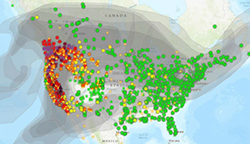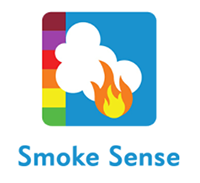May 5: Citizen Science & Sensors
Citizen science is the practice of public participation in scientific research and data collection. Citizen scientists apply their curiosity and diverse talents to science and technology, often to learn more about topics that affect their lives personally. Through this, they can contribute new and innovative tools to the field as well as provide information that would otherwise not be available due to time, geographic, or resource constraints of organizations.
Citizen science and low-cost sensors are an exciting and growing part of air quality awareness. Air sensor monitors that are lower in cost, portable, and generally easier to operate than regulatory-grade monitors are widely used for citizen science to understand air quality conditions. They can be used by anyone and everyone, making learning about air quality measurement more accessible to communities. Air sensors are a valuable educational tool, although they do not replace regulatory monitors, which have met rigorous scientific review.
EPA is involved in the advancement of air sensor technology, including performance evaluations of sensor devices and best practices for effectively using sensors. The information can help the public learn more about air quality in their communities.
WHAT'S HAPPENING?
Air Sensors Video Series
 EPA has developed an educational video series about air sensors that is available in both in English and Spanish.
EPA has developed an educational video series about air sensors that is available in both in English and Spanish.
Fire & Smoke Map: Adding Sensor Data
 As wildfires impacted western states last summer and fall, many people turned to the AirNow Fire and Smoke Map to understand how smoke was affecting their air quality. As part of a pilot project conducted by EPA and the U.S. Forest Service, many people were able to see air quality information in their areas for the first time. The AirNow Sensor Data Pilot added data from more than 7,000 low-cost air sensors to the map to supplement data from existing regulatory and temporary monitors that measure fine particulate matter, or PM2.5, an air pollutant found in smoke that is harmful to health. The pilot employed a correction equation developed by EPA researchers to make the data from PurpleAir sensors more comparable to data from the regulatory and temporary monitors. EPA and the Forest Service will continue to use the map to pilot updates to make it even more useful to the public.
As wildfires impacted western states last summer and fall, many people turned to the AirNow Fire and Smoke Map to understand how smoke was affecting their air quality. As part of a pilot project conducted by EPA and the U.S. Forest Service, many people were able to see air quality information in their areas for the first time. The AirNow Sensor Data Pilot added data from more than 7,000 low-cost air sensors to the map to supplement data from existing regulatory and temporary monitors that measure fine particulate matter, or PM2.5, an air pollutant found in smoke that is harmful to health. The pilot employed a correction equation developed by EPA researchers to make the data from PurpleAir sensors more comparable to data from the regulatory and temporary monitors. EPA and the Forest Service will continue to use the map to pilot updates to make it even more useful to the public.
Smoke Sense Study: A Citizen Science Project Using a Mobile App
Smoke Sense is a crowdsourcing, citizen science research project developed by EPA researchers focused on increasing public awareness and engagement related to wildfire smoke health risks. Specifically, EPA wants to understand the extent that exposure to wildland fire smoke affects health and productivity, discover what steps people are willing to take to reduce their exposure, and develop health risk communication strategies that improve public health when there is wildfire smoke.
https://www.epa.gov/air-research/smoke-sense-study-citizen-science-project-using-mobile-app
OTHER RESOURCES
Air Sensor Toolbox
Air Sensor Toolbox provides the latest science on the performance, operation and use of air sensor monitoring systems for technology developers, air quality managers, citizen scientists, and the public.
https://www.epa.gov/air-sensor-toolbox
CitizenScience.gov
CitizenScience.gov provides a portal to three key components: a catalog of federally supported citizen science projects, a toolkit to assist federal practitioners with designing and maintaining their projects, and a gateway to a community of hundreds of citizen science practitioners and coordinators across government as called for in the Crowdsourcing and Citizen Science Act of 2016 (15 USC 3724).






